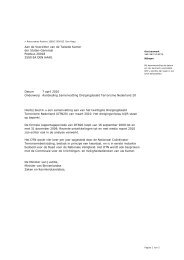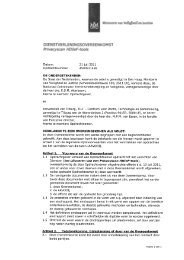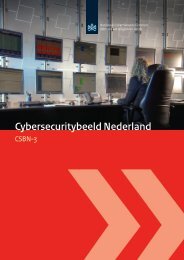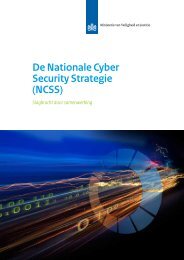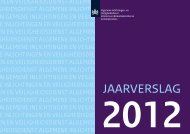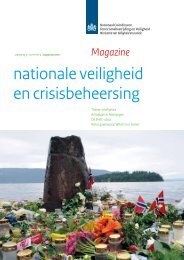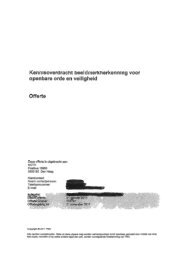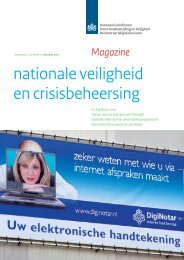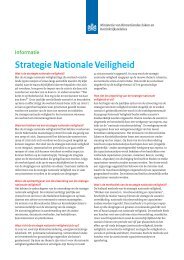third Cyber Security Assessment Netherlands - NCSC
third Cyber Security Assessment Netherlands - NCSC
third Cyber Security Assessment Netherlands - NCSC
You also want an ePaper? Increase the reach of your titles
YUMPU automatically turns print PDFs into web optimized ePapers that Google loves.
However, it is assumed that they are involved with many DDoS<br />
attacks and with (attempts at) publications of the information<br />
stolen in digital break-ins.<br />
As far as we know, to date there have been no cyber attacks by<br />
terrorists against the internet or by the internet to create disruptive<br />
damage. It seems that terrorists do not (yet) have sufficient skills<br />
and means to carry out cyber attacks that could disrupt society.<br />
Threats: tools<br />
Attackers use (technical) tools to abuse and/or to increase vulnerabilities.<br />
These actors mainly rely on countless self-developed<br />
or readily available exploit kits, botnets, (spear) phishing, and<br />
(mobile) malware. States can develop and deploy advanced tools,<br />
while cyber criminals continue to develop their particular existing<br />
tools. <strong>Cyber</strong> crime is becoming increasingly professional, offering<br />
services and tools for hire, for mounting cyber attacks and siphoning<br />
off money. This criminal cyber services sector is also known<br />
as ‘cyber crime as a service’. Renting out botnets for DDoS attacks<br />
is one example of this.<br />
The most commonly used technical tools are exploit kits, malware,<br />
and botnets. With exploit kits becoming easier to use, it is becoming<br />
simpler to abuse the rising number of technical vulnerabilities.<br />
Even tools for use in DDoS attacks are relatively easy to come by.<br />
Mutations in malware mean that there are so many variants in<br />
circulation that anti-virus programs cannot detect them all. Botnets<br />
continue to be an important tool for states and cyber criminals,<br />
and they often remain under the radar for the owners of misused<br />
IT systems. With the increase in the use of mobile devices, there was<br />
also an increase in mobile malware.<br />
On the human side, we see that criminals are becoming more<br />
daring. Phishing continues to be a successful method with which<br />
to tempt users, and users are more often becoming the victim of<br />
ransomware, a specific form of malware used to kidnap the user’s<br />
computer. Phishing actions by telephone were particularly notable<br />
in the past year.<br />
Resilience: vulnerabilities<br />
Resilience involves protecting interests from their vulnerabilities<br />
either by removing (the absence of ) the vulnerability or by taking<br />
measures to reduce the vulnerability. As long as vulnerabilities exist,<br />
our society will remain exposed to cyber attacks.<br />
The IT sector continues to be highly vulnerable. Following a few<br />
years of reduced levels, the number of openly published vulnerabilities<br />
in software is increasing again (+27 per cent) and the number of<br />
published vulnerabilities in industrial control systems is also rising.<br />
Data has become mobile and loss or theft of mobile devices makes<br />
the data stored on these devices possibly accessible to the finder.<br />
In the case of hyperconnectivity, all types of devices are connected,<br />
not only smart phones, tablets or computers, but all forms<br />
of devices imaginable, from fridges to cars, which means that the<br />
existing vulnerabilities can be abused in a wide variety of ways.<br />
The end-user holds a great responsibility for security, but increasingly<br />
often faces vulnerabilities in devices over which he has little<br />
influence. In addition, security for computers and other devices<br />
requires knowledge that many end-users do not have. Also, consu -<br />
merisation means that private and business usage has merged, and<br />
some combinations are not always compatible. Business information<br />
is being taken out of an organisation’s area of influence to<br />
become susceptible to leaks. At the same time, private information<br />
is becoming accessible to organisations.<br />
Cloud computing has many advantages, but it introduces risks as<br />
well, including the fact that access is not always well protected and<br />
the cloud reduces the autonomy of organisations relating to the<br />
quantity of requests from foreign governments. Cloud computing<br />
presents challenges for the detection and prosecution of crime.<br />
Many organisations do not have basic measures in order, such<br />
as patch and update management or a password policy. This is why<br />
old vulnerabilities and methods of attack are still effective. Finally,<br />
one crucial vulnerability is that many organisations do not have<br />
the necessary knowledge, detection methods, and ability to handle<br />
incidents well.<br />
Resilience: measures<br />
Many initiatives involving resilience that were cited in the previous<br />
edition of the CSBN either have been started or are now in full<br />
swing. During the past year - partly because of large incidents - the<br />
public and political attention towards cyber security has noticeably<br />
increased. The need has also reached the boardroom, meaning<br />
that the subject of cyber security or information security is often<br />
given great importance. The government and the business<br />
community pay more attention than previously to measures and<br />
this also happens more often in collaboration.<br />
Noticeable examples of this are the campaigns for raising awareness,<br />
such as ‘Alert Online’, ‘Bank data and log-in codes. Keep them<br />
secret’ and ‘Protect your company’. In addition to this, closer collaboration<br />
in the area of exchange of information and the agreements<br />
reached between banks and the government in connection with<br />
the DDoS attacks are good examples. In the area of research and<br />
innovation there have been various research programmes set up for<br />
the purpose of tackling the issues in connection with cyber security<br />
in collaboration between the government, the business community,<br />
and the academic community. A guideline has also been published<br />
for setting up a policy of responsible disclosure, which involves<br />
pointing out IT vulnerabilities in a responsible manner. This is<br />
a handout for organisations and reporters as to how vulnerabilities<br />
in information systems and (software) products can be reported and<br />
dealt with in a responsible manner.<br />
The increased awareness has also recently led to new initiatives and<br />
supplementary measures at a national level and in individual<br />
organisations. They thus respond to the ever-increasing dependence<br />
on IT and changing threats. The effectiveness of the initiatives<br />
can only be measured in the long term.<br />
10



